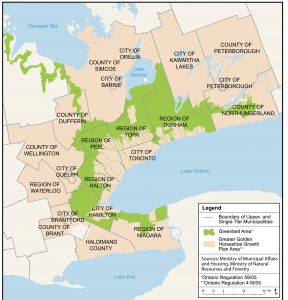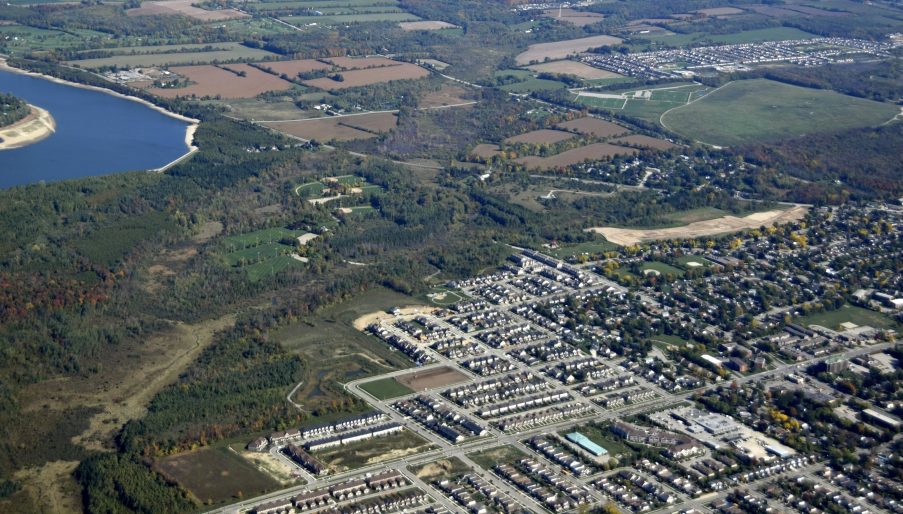Ontario’s Greater Golden Horseshoe (GGH) is expected to grow substantially by 2051 at a projected rate of one million people every five years. In late March, the provincial government rolled out a transportation plan addressing gridlock issues and infrastructure, an investment that should trigger a boon in housing development particularly in neighbourhoods connected by transit. But will this intensification include enough affordable housing, and will municipalities say yes to vertical growth?
With transit and transportation pushing the vision forward, housing development is sure to follow—because mobility and connectivity are the foundation of any thriving community. In 2019, Ontario’s A Place to Grow document painted a picture of vibrant GGH urban centres characterized by “compact development patterns” and buildings that would support climate change mitigation. Future housing supply would be dependant on each market’s geography—built-up, greenfield and rural areas—with zoning determined by the municipality.
Since then, Ontario’s “Vision for Mobility” was released, and some are seeing red where they should be seeing green. Not everyone is in favour of a plan that would take away fertile farmlands, transplant more single-family homes, and cut a massive highway through the Paris Galt Moraine, a 130-kilometre geological feature formed by glaciers some 12,000 years ago. Furthermore, many believe it doesn’t go far enough to address the province’s housing woes. In recent days, “No Sprawl” groups have taken to social media to fight Ford’s vision and criticize his lack of regard for both the environment and affordable housing.

“Stop sprawl, create housing that people need – rental housing, supportive housing, well-designed accessible housing in or near our existing cities/transit,” tweeted Friends of the Greater Golden Horseshoe, a group advocating for good land-use planning, affordable housing, sustainable transportation, and productive farmlands. “Suburban sprawl is bad for the economy. If people can’t afford to live in cities where the economy is most productive, our collective gains are muted.”
Steve Lafleur, Senior Policy Analyst at the Fraser Institute, points to the stress that the rapidly growing population is already putting on housing prices. “Not just in Toronto, but all throughout the GGH region,” he said. “We can accommodate that demand by building upwards, outwards, or both. Given that the province is committed to restricting sprawl development in the Greenbelt, that leaves us with primarily building upwards. However, municipal governments don’t appear to be all that open to intensifying existing areas.”
Lafleur referenced a recent report by the Ontario Housing Task Force that proposed allowing landowners the right to build up to four units on their residential lot as-of-right to bypass local political opposition. “That would be a major step towards freeing up the housing market to respond to demand,” Lafleur said. “The Minister of Municipal Affairs and Housing announced he will consult with municipalities about building more ‘missing middle’ housing. This is a positive sign, but there’s nothing that difficult about building more duplexes and triplexes.”
In fact, other jurisdictions have already introduced similar zoning changes, including Edmonton and Minneapolis, so making the move wouldn’t be unprecedented. “We’re in a housing crisis, therefore some urgency is warranted,” he said. “While steps to speed up the approval process are justified, giving people more freedom to build on their own land is a critical part of the solution.”
Inside Ford’s GGH transportation plan
Entitled, Connecting the GGH: A Transportation Plan for the Greater Golden Horseshoe, the province’s vision for improving mobility throughout Canada’s busiest economic hub includes moving forward with the controversial Highway 413 and the Bradford Bypass, and building the largest subway system in Canadian history. Ontario’s Transportation Minister, Caroline Mulroney, prefaces the document with: “A well-functioning transportation system is critical to Ontario’s economic prosperity and the quality of life for the nearly 15 million people who will call the GGH home by 2051.”
It’s hard to argue against improved transportation infrastructure. But the question remains, will the right mix of housing come of it? Recent data shows that many hot markets outside the Greater Toronto Area had been suffering from housing shortages well before COVID-19. While the pandemic diminished rental demand in the short-term, that demand is back, and some suburban markets are hotter than ever thanks to the rise of home offices and the continued exodus from downtown in seek of more affordable, spacious dwellings. Although recent Urbanation data reveals there’s a surge of housing development underway, including purpose-built rental construction, it won’t be enough to offset the growing need.
In the meantime, Premier Ford is focusing on transportation and the prosperity it will bring to the fast-growing Greater Golden Horseshoe region for years to come: “Our government is saying ‘yes’ to building the roads, highways and public transit needed to unlock our full economic potential and keep our province moving forward,” he professed in March. “As we attract more skilled workers to Ontario, we need to build more roads and highways to keep up with population growth. Highway 413 and the Bradford Bypass are a critical part of our plan to build Ontario as we connect communities, reduce gridlock, and get goods to market sooner.”
Wayne Emmerson, Chairman and CEO, The Regional Municipality of York, concurred: “Investments in transportation help support our growing communities and provide residents and travellers with an enhanced transportation network whether walking, cycling, taking transit or driving. Projects like the Bradford Bypass will make life easier for people by alleviating gridlock that already exists on our roads and highways.”
“A place to Grow” framework
Ontario’s “A Place to Grow” plan aims to address the needs of the region’s growing population, diversity, people and priorities, with policies intended to:
- Build communities with a diverse range of housing types
- Support a robust economy with many different job opportunities
- Provide better transit connections between where people live and work
- Support a thriving agricultural sector and community
- Protect local water systems, wetlands, woodlands, plants and animals
Visit www.ontario.ca for more information on the Greater Golden Horseshoe growth plan and related housing policies.






